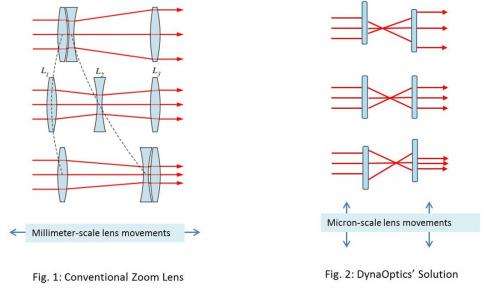October 1, 2014 weblog
Optical zoom in mobile phones getting boost from DynaOptics

DynaOptics wants to make a difference in bringing optical zoom to mobile phones without having to make do with a thicker phone or put up with a protruding zoom lens.
The company, founded in 2012, has worked on rethinking conventional zoom systems and is coming up with impressive results. According to their vision, the hardware that will come inside the next new phone you buy will make a real difference. IEEE Spectrum reported last month that DynaOptics is all about fitting optical zooms into a slim smartphones. As Tekla Perry suggested in the article, "Smartphones are missing an optical zoom. Or if a smartphone has one, you probably don't love it, because the zoom assembly sticks awkwardly out of the phone." The company said that traditional mechanically-compensated zoom lenses require millimeter-scale movements along the optical axis, resulting in a protruding, telescopic structure. DynaOptics set about to engineer something different. The company said that its patented technology solution enables optical zoom capability via micron scale, lateral lens movements, resulting in a footprint that is a fraction of the size of current optical zoom systems.
Commenting on the technology, Lars Rehm in dpreview.com said that the optical zoom technology the company developed would fit into even the very slim bodies of current high-end devices. "To achieve this, DynaOptics does away with the conventional zoom setup, which involves lens elements moving along the optical axis to change focal length. Instead, it uses a new system that achieves the same effect with aspherical lens elements moving laterally on a micron-scale." PetaPixel said, "DynaOptics' solution will rid us of the bulk-for-zoom trade-off by using asymmetrical lenses. Basically, rather than moving in-and-out to zoom, as most conventional optical zoom setups do, these lenses can simply slide up, down, left and right."
The company makes note how its system comes "without the bulky footprint." They said they used techniques adapted from industries such as metal stamping and plastic injection molding. How long will it be before consumers have mobile devices with the technology? The company said it will have engineering samples available for mobile device makers during the first quarter of 2015 and will be ready to undertake mass production by late 2015.
The R&D team is based in Singapore and business development is based in San Francisco. The company said its goal is to help mobile photographers create the best images possible. "Optical zoom provides more flexibility while maintaining image quality. You deserve the best. You shouldn't have to lose pixels when you want to get in closer."
More information: www.dynaoptics.com/
© 2014 Tech Xplore



















